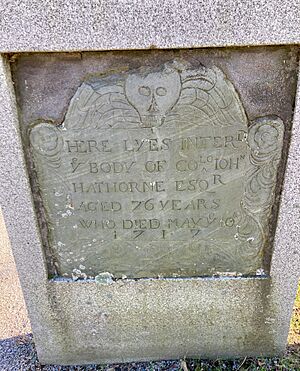John Hathorne facts for kids
Quick facts for kids
John Hathorne
|
|
|---|---|
| Justice of the Salem witch trials | |
| In office May 1692 – June 1692 |
|
| Associate Justice of the Massachusetts Superior Court of Judicature | |
| In office 1702–1712 |
|
| Personal details | |
| Born | Baptized August 2, 1641 Salem, Massachusetts Bay Colony |
| Died | May 10, 1717 (aged 75) Salem, Massachusetts |
John Hathorne (born August 1641 – died May 10, 1717) was an important person in the early Massachusetts Bay Colony. He was a merchant, meaning he bought and sold goods, and a magistrate, which is like a judge. He is most known for being one of the main judges during the famous Salem witch trials.
Hathorne was not part of the special court that handled the trials in June 1692. However, this court used many of the statements and questions he had already collected. These included things like "spectral evidence," which was when people claimed to see the accused person's spirit doing harm. Unlike another judge, Samuel Sewall, John Hathorne never said he was sorry for his part in the trials. He was also a great-great-grandfather of the famous writer Nathaniel Hawthorne.
Contents
Early Life and Career
John Hathorne's father, Major William Hathorne, was one of the first people to settle in the Massachusetts Bay Colony in the 1630s. He held many important jobs in the military and government. John was born in Salem in August 1641. Records show he was baptized on August 2.
In 1674, John married Ruth Gardner in Salem. Her grandfather, Thomas Gardner, was also an early settler of Salem. John Hathorne built on his father's success. He grew his family's business, which involved owning land and trading goods with England and the West Indies. He also owned land in what is now Maine.
Hathorne became a powerful figure in Salem. He was appointed a justice of the peace for Essex County. This meant he helped keep order and settle arguments. He also served on the colony's council, which was like a mix of a law-making group and a high court. In this role, he helped solve disagreements in towns like Salem Village, which is now Danvers.
Role in the Salem Witch Trials
In early 1692, people in Salem Village started accusing others of witchcraft. John Hathorne and another judge, Jonathan Corwin, were called to question both the people making accusations and those who were accused. They needed to decide if there was enough reason to hold a trial. Other officials from Boston later joined them.
Hathorne's way of questioning people was often described as quite harsh. Many historical stories about the trials show him as someone who believed the accused people were guilty. He is especially remembered for how he questioned two women, Rebecca Nurse and Bridget Bishop. Here is a small part of his questioning of Bridget Bishop:
- Bishop : I am no witch.
- Hathorne : If you have not written in the book, tell me how far you have gone?
- Bishop : I have no friendship with the devil.
- Hathorne : How is it then, that your appearance hurts these people?
- Bishop : I am innocent.
- Hathorne : You seem to be doing witchcraft right now by how your body moves. This seems to affect the people who are suffering.
- Bishop : I know nothing of it. I am innocent of being a witch. I don't know what a witch is.
- Hathorne : How can you know you are not a witch, and yet not know what a witch is?
- Bishop : I am clear...
- --From the records of the Salem witchcraft trials, 1864
In May 1692, a special court was created to handle the trials. This court was called the Court of Oyer and Terminer. Governor Sir William Phips did not choose Hathorne to be part of this special court. This court found 19 people guilty and they were executed for witchcraft.
In 1693, a new court, the Superior Court of Judicature, replaced the special court. Hathorne was not immediately on this new court. This court found most of the accused people innocent. The few people it did convict had their convictions overturned by Governor Phips.
Later Years and Legacy
After the witch trials, in the late 1690s, Hathorne became more involved in the military. He followed in his father's footsteps. He led colonial forces during King William's War. For example, he was part of the 1696 Siege of Fort Nashwaak in what is now Fredericton, New Brunswick. He continued to be active in the colonial army and was promoted to colonel in 1711.
He was also finally appointed to the Superior Court by Governor Joseph Dudley. He held this position until 1711. John Hathorne died in Salem in 1717. He is buried in the Old Burying Point Cemetery. Many of his family members are also buried there.
Nathaniel Hawthorne and His Ancestor
John Hathorne was the great-great-grandfather of Nathaniel Hawthorne. Nathaniel Hawthorne is a very famous American writer. He wrote many well-known books, including The Scarlet Letter and The House of the Seven Gables.
The House of the Seven Gables is set in Salem. It includes hints about the witch trials in the history of the house in the story. Nathaniel Hawthorne was quite upset and felt deeply ashamed about his ancestor's role in the trials. He was especially bothered that John Hathorne never showed regret for his actions. Nathaniel may have even changed the spelling of his last name from "Hathorne" to "Hawthorne" to distance himself from his ancestor, the judge.


